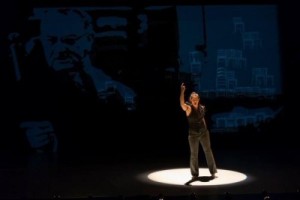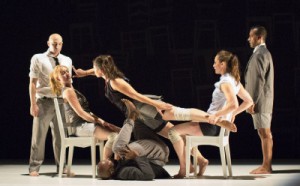Editor's Note
The following is a guest post by Michael J. Kramer. It originally appeared at his blog. It nicely complements Michael’s “Ideology” plenary comments from the 2014 S-USIH Conference, a revised edition of which appeared at the blog here.
Michael J. Kramer specializes in modern US cultural and intellectual history, transnational history, public and digital history, and cultural criticism. He is an assistant professor of history at the State University of New York (SUNY) Brockport. His website can be found at michaeljkramer.net.
Over the past two years, I have worked as dramaturg and historian with The Seldoms Dance Company on their new work, Power Goes, which uses Lyndon Baines Johnson and the protests of the 1960s as a springboard for an exploration of how power relates to social change. The piece appears as part of the Museum of Contemporary Art Chicago’s MCA Stage program from March 20-29, 2015. Here is an essay that arose out of this engagement: “How To Get Power.”

Christina Gonzalez-Gillett gives audiences the “Johnson Treatment” in The Seldoms’s Power Goes. Photo by Bill Frederking.
One claim The Seldoms make is that choreography has something “to say” about pressing issues of our times, that one might even be able to mount an argument in movement. For historians, as with most audiences, this makes for unusual territory. We are far more used to language and text—and perhaps, for some, images and visualizations—as the domain of interpretation. Performance that is centered on the body and gesture demands of us a broader repertoire of what counts as an argument, how evidence is wielded, and how positions are conveyed. Performance Studies scholars are comfortable on this terrain. Despite many nods in the direction of history of the body, historians have a way to go.

The Seldoms in Power Goes. Photo by Bill Frederking.
What’s the point? This is often asked of performance, particularly when it appears in more experimental and daring veins. Of course the irony is that the question itself refers to gesture. The point is to point out ideas, concepts, perceptions, emotions, contentions that cannot be reduced to language alone. The point (befitting in this case of a work about power) is to expand the power of argument by widening its avenues of articulation. What interpretations can be contained in a fist raised in the air or shoved into the ground? What comprehensions of power lurk in bodies that move in unison? How does conflict or persuasion or social transformation begin with something as mysterious as someone tugging on someone else’s hair?
Language falls short here (note again the language of gesture!). New ideas about argument, fresh understandings of long-running questions about how change happens (or doesn’t) erupt from the interplay of dance, speech, set design, lighting, sound collage, music, and video design in Power Goes. These are at once evocative and provocative modes of expression, capable of doing things that words alone cannot.
Dance possesses a deep history of its own, of course, but it also might become a compelling part of intellectual history methods. Bringing dance’s physicality into play with language, placing its capacities for new kinds of comprehension and communication within intellectual history’s mix of evidence and interpretation, form and content, positioning and reasoning—this can only extend our ability to understand thought in all its dimensions. The ideas of bodies should join the body of ideas.

2 Thoughts on this Post
S-USIH Comment Policy
We ask that those who participate in the discussions generated in the Comments section do so with the same decorum as they would in any other academic setting or context. Since the USIH bloggers write under our real names, we would prefer that our commenters also identify themselves by their real name. As our primary goal is to stimulate and engage in fruitful and productive discussion, ad hominem attacks (personal or professional), unnecessary insults, and/or mean-spiritedness have no place in the USIH Blog’s Comments section. Therefore, we reserve the right to remove any comments that contain any of the above and/or are not intended to further the discussion of the topic of the post. We welcome suggestions for corrections to any of our posts. As the official blog of the Society of US Intellectual History, we hope to foster a diverse community of scholars and readers who engage with one another in discussions of US intellectual history, broadly understood.
I really loved this post, Michael, specially the concluding sentence: you signal quite poignantly the importance of analyzing ideas and bodies–both human and nonhuman–together. Do you see this relation in dialectical terms, or immanently? The affective turn has helped much in this regard, pointing out how discourse carries and circulates an aura of affect; this aura is also a trace of bodies. Our own rhetoric can also be read in this way, how we articulate our own affective performances in our work, not unlike James Livingston did in his interpretation of Walter Johnson.
One might ask too “how does conflict or persuasion or social transformation begin with something as mysterious” as the trace of affect.
Kahlil —
Thank you many times over for this wonderful comment. I am particularly intrigued by how you use the term “trace.” Because it’s something that both bodies and words can do.
While in theory, I love the idea of a more immanent relationship between something such as dance and language, of some radically different flow between the two than we typically employ as historians, I think in practice, as dramaturg/historian, my own work with The Seldoms has been more dialectic (if I am understanding how you are using those terms, and clarify and correct me if I am not, please!). In the sense that my task is to supply words and ideas that feed into the choreographic process and then respond in language to the resulting artwork, translating it back into spoken and written rhetoric and discourse as best I can (my How To Get Power essay would be an example of this dialectic, written more for a general audience: http://www2.mcachicago.org/2015/how-to-get-power/.
Could we actually have a more fluid relationship between dancing and writing intellectual history? Maybe. After all, as you suggest, the line between body and word is not as distinct as we sometimes pretend. Words perform. Bodies speak.
It does lead easily to the the age-old graduate student joke about presenting your Ph.D. thesis as an interpretive dance. That is in fact now an actual contest– http://gonzolabs.org/dance/ — one that is in turns silly and absolutely fabulous and profound.
I will say that I have seen dance studies scholars and performance studies scholars—also practitioners of dance or performance—criss-cross this line in wonderful ways (for instance, Rebecca Rossen at UT Austin often starts her academic talks with an excerpt from a related dance piece she created). And of course, in some sense we are always performing–language is a bodily practice in the end (shoo Rene Descartes, shoo!).
But now that I think about it more, there is also value in a more dialectical approach that uses the gap we assume exists between bodies and language to its advantage. Because there is some kind of catalytic energy, some kind of charge, that gets generated out of the movement across that synapse, the leap across that distance we perceive between body and word (starting to sound a touch ecclesiastical here aren’t I–people have been thinking about the body and the word for a long time!). For me, it is in the dialectical translation back and forth between dance and talking/writing/discoursing about dance where I have found the capacity to generate satisfying intellectual content and value. Assuming a distance between the two, then translating and, er, leaping/talking across it—something fulfillingly ideational arises out of that. Why? That’s an important question to consider.
I should issue the caveat that this is just me. I suspect performance studies scholars would have a very sophisticated take on this question of embodiment and discourse. On the other hand (body again!), some intellectual historians might recoil from the assertion of the body as important here (and in their recoiling, once again show how physicality and affect are foundational to ideas and texts and language and words, thus contradicting their own argument… touche!).
Back to “trace” and your last question: “One might ask too ‘how does conflict or persuasion or social transformation begin with something as mysterious’ as the trace of affect.”
Perhaps not only the trace of affect is at issue here, but also the affect of trace. What it means to trace things, with both limbs and letters, that might be the lurking question. The trace happens within bodies (!) of texts. It also happens in a dance performance such as Power Goes by The Seldoms, which is so full of spoken words—or written words on screens— that, in their way, right with the dancers’ bodies themselves, dance too.
Michael